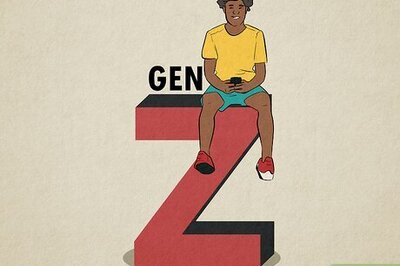
views
New Delhi: The riots at the time of India’s partition demoralised and damaged members of the Muslim community. Yet, in the moment of hatred and heat, the student fraternity of Jamia Millia Islamia (JMI) tried to convince them to stay back. The faith they invested was in the inclusiveness of the country.
These are the views of scholar Laurence Gautier, who got her MPhil and PhD degrees at the University of Cambridge, working on Muslim universities in post-Partition India. She now teaches at OP Jindal Global University.
Jamia in Delhi has grabbed headlines over the past week after its students emerged as forerunners of protests that have spread across the country against the amendments brought in India’s Citizenship Act this month by the Narendra Modi government at the Centre. The revised law, termed “anti-Muslim” by detractors, will help provide Indian citizenship to those Hindu, Christian, Sikh, Buddhist, Jain and Parsi refugees who fled religious persecution from Pakistan, Afghanistan and Bangladesh, and entered the country before January 1, 2015.
It is a fairly well known chapter of history that Jamia Millia Islamia sprung from the Muhammadan Anglo-Oriental College (MAOC) – the predecessor of Aligarh Muslim University (AMU) that has also witnessed massive protests against the rejigged citizenship law.
JMI a ground for reconciliation in times of riots
“In 1947, the students and teachers of JMI tried to convince the Muslims to choose inclusive India. Dr Zakir Husain, who was the vice-chancellor of the central university for 22 years and India’s President from May 1967 till his death in May 1969, gave a speech in which he urged Muslims to stay and play their part in ‘saving Delhi from communal violence’. Husain made the speech in 1946 during Jamia’s silver jubilee celebrations and tried to bring Muhammad Ali Jinnah and Jawaharlal Nehru together to stop the escalation of violence,” said Gautier.
She added, “Jamia students got involved in relief work in evacuation camps around Humayun’s Tomb and Purana Qila at the time of Partition and riots. They tried to encourage Delhi’s Muslims to stay on. As tensions flared, some of them established a school between the Old City and Karol Bagh that welcomed everyone irrespective of religion, including Hindu and Sikh refugees who had fled from Pakistan. The Muslims and non-Muslims in Delhi were brought together as a gesture and effort of reconciliation. Jamia also hosted refugee children on its campus in Jamia Nagar.”
Gautier said there were special efforts towards reconciliation. Dr Zakir Husain attempted to present the “tolerant face of Islam” to everyone.
Born at the call of Gandhi
Jamia was born in Aligarh as a result of a rupture within MAOC.
In the 1920s there were the “non-cooperation movement and Khilafat movement”. A tussle sprung up when the Ali brothers, and Old Boys Association activists demanded from the MAOC management to dissociate from colonial assistance. “There was no agreement on that as MAOC was focused on modelling education on the Oxbridge model,” said the director of the Urdu Academy at AMU Rahat Abrar. So “the association members, with freedom fighters dominating, broke away and established Jamia on the call of Gandhi as we all know”, he added.
Gautier pointed out that the Ali brothers (Shaukat Ali and Mohammad Ali Jauhar) were part of the Khilafat and non-cooperation movements and were closely fighting together against the colonial authority which had influence on MAOC. “Gandhi visited MAO College, in the wake of the non-cooperation movement to convince students and teachers to break away from the loyalist attitude of the institution toward colonial authorities,” she said. “It was in line with founder Sir Syed Ahmad Khan’s idea to establish better relations with the colonial authority.”
Then in 1920, the anti-colonial section broke away from the MAOC management. “They could not convince authorities for a separate institution, and then JMI was born. But at first, the Ali brothers had not planned to break away from Aligarh. They wanted to transform Aligarh, have a national university for Muslims, which would be independent of colonial authorities,” said Gautier. “Since they could not convince Aligarh’s authorities, they moved to Delhi.”
Gautier’s research explains that at the time, Jamia was often presented as a “counter to Aligarh – anti colonial. It even adopted Hindustani medium of instruction, rather than English, as it was in MAOC. It was less hierarchical and more egalitarian”.
Professor Mohammad Mujeeb, brother of Mohammad Habib and uncle of Irfan Habib – both famous historians – was one of Jamia’s leading figures. After 1948, he became Jamia’s vice-chancellor till he retired in 1973, one of the longest- serving persons on the position.
“Khilafat and non-cooperation ended and Jamia was fighting for survival. At this time Prof Mujeeb focused on making Jamia a laboratory for the conception of the Indian nation and pursuing meaning as citizens,” Gautier said. Zakir Husain was Jamia’s V-C from 1925 to 1948. It is at this time that these actions took place. Mujeeb, who joined Jamia in 1925, at the same time as Zakir Husain, became the V-C in 1948. He tried to pursue the same policies.
He said Jamia’s mission was to lay the foundation for meaningful independence. In his words: “To train young men as citizens for carrying on the struggle for freedom and for giving meaning and content to freedom once it had been achieved.” The important point here is that Jamia members apparently wanted to contribute to an independence that would be meaningful to all, Muslims and non-Muslims.
'AMU a sign of Muslim integration, not a memory of separatism'
“After Partition, AMU was seen as a starting point of Muslim separatism. This is very problematic, as we cannot draw a direct connection between Sir Syed’s idea and Partition because there was no conception of a Muslim nation at the time of MAOC,” Gautier said.
AMU has also been blamed for supporting Pakistan. “It was never a unanimous movement for Partition. Socialist, communist and nationalist ideas also had a powerful influence among students and teachers before Partition. It is only in the 1940s that the Muslim League gained more prominent influence,” she said.
“But we must understand that even when there was some support for Pakistan, the idea of Pakistan was not clear – for many it was just a shelter for Muslims in the subcontinent in case of violence,” said Gautier. “The idea of Pakistan could mean different things to people: it could be a way to escape ‘Hindu Raj’, it could also be the promise for Muslims to exert political power again and to uplift the community. It was not clear, even to supporters of Pakistan, that India and Pakistan would become separate nation states.”
After Partition, AMU became for many critics a memory site of the division and a target of anti-Muslim attacks, said Gautier. “However, Maulana Azad and Pandit Jawaharlal Nehru were keen to transform AMU as a symbol of national integration and send the message across that Muslims were part of the Indian nation,” she added. “In independent India, AMU became a symbol of national integration.”

















Comments
0 comment